
The transition from one year to another is a universally celebrated phenomenon, marked by diverse beliefs, customs, and rituals across the globe. New Year’s Day serves as a symbolic canvas upon which different cultures paint their unique expressions of hope, renewal, and cultural identity. This article explores the rich history of traditions, shedding light on the myriad ways in which people welcome the promise of a new beginning.
The most widely recognized celebration is based on the Gregorian calendar, introduced by Pope Gregory XIII in 1582, replacing the Julian calendar. This calendar realignment, aligning dates more accurately with the solar year, designated January 1st as the start of the year—a tradition that has persisted for centuries.
As the clock strikes midnight, many individuals around the world engage in the tradition of making resolutions for prosperity, transcending cultural boundaries and reflecting a collective desire for self-improvement. Whether committing to healthier habits, pursuing educational goals, or fostering stronger relationships, resolutions symbolize the human drive for personal growth.
In contrast to the Western world, many Asian cultures celebrate the New Year according to the lunar calendar. The Chinese New Year, known as the Spring Festival, is a vibrant celebration observed by billions, featuring dragon and lion dances, colorful parades, and red envelopes containing money for good luck.
For Hindus, the festival of Diwali serves as a momentous celebration, symbolizing the triumph of light over darkness and good over evil. Families come together to illuminate their homes, exchange gifts, and partake in feasts—a time for reflection, gratitude, and forging new beginnings.

Rosh Hashanah, the Jewish celebration for the upcoming year, is a solemn and reflective time observed with prayer, introspection, and the sounding of the shofar. Symbolizing the anniversary of the creation of Adam and Eve, Rosh Hashanah marks the beginning of the High Holy Days, with traditional foods like apples dipped in honey symbolizing hopes for a sweet and fruitful year ahead.
In Thailand, the traditional rollover is celebrated with Songkran, a water festival marking the arrival of the Thai. Exuberant water fights symbolize the cleansing of the old year’s misfortunes and the welcoming of the new year with purity. Songkran is also a time for paying respects to elders, visiting temples, and making merit.
Nowruz, or “New Day,” is the Persian festival celebrated across Central Asia, the Middle East, and parts of the Caucasus. Marking the vernal equinox and the beginning of spring, Nowruz traditions include the preparation of the “Haft-Seen” table, featuring seven symbolic items representing different aspects of life.
In Scotland, the celebration is known as Hogmanay, is a lively affair with diverse traditions, including “first-footing” and fire festivals. Japanese New Year’s Eve, known as Omisoka, involves a day of preparation and reflection, with families gathering for a festive meal symbolizing the crossing from one year to the next.

The iconic New Year’s Eve celebration in Times Square, New York City, with the dropping of the glittering ball at midnight, has become synonymous with bidding farewell to the old year and welcoming the new. Across cultures, fireworks are a common element in celebrations, symbolizing the triumph of light over darkness.
New Year’s Day is often accompanied by a myriad of superstitions rooted in cultural beliefs, such as eating 12 grapes in Spain or wearing white clothing in Brazil. In some cultures, the eve before is marked by the burning of effigies or symbolic representations of the old year, symbolizing the casting away of the past and the embrace of new possibilities.
The celebration of an annual starting time has evolved over centuries and across various cultures, encompassing a rich variety of traditions, customs, and rituals. From ancient beginnings with the Babylonians and Egyptians to the influence of the Roman calendar and the adoption of the Gregorian calendar, forthcoming year celebrations have adapted and diversified.
In the medieval and Renaissance eras, various celebratory dates were observed, often linked to religious events. The 19th and 20th centuries saw the global spread of year ahead observances, with the integration of diverse cultural elements. Today, commemorations vary widely, incorporating local customs, religious practices, and regional festivities. A common ritual practiced throughout the world on this very special occasion, for centuries, is the use of lit firecrackers, the launching of fireworks, guns; especially long and big guns being fired, and in some cases even cannons being fired. The very loud noises were thought to scare away evil spirits; demons.

In the contemporary era, globalization and technology have further influenced the way the year to come is celebrated. The advent of television and the internet allows people worldwide to witness and participate in celebrations from different time zones. Social media platforms facilitate the sharing of Happy greetings and resolutions on a global scale.
Despite the diversity, the underlying theme of hope, renewal, and the anticipation of a better future remains a constant across cultures and time periods. Here are examples of prayers on New Year’s Day from different religions:
Christianity: “ Father, as we stand at the beginning of this new year, we place it in Your hands. We ask for Your guidance in the coming days, that we may walk in your light and fulfill the purpose you have for each of us. Bless our endeavors, grant us wisdom, and help us to be a source of love and kindness in the world. In Jesus’ name, we pray. Amen.”
Islam: “O Allah, the Lord of the heavens and the earth, we seek Your guidance and blessings as we embark on this new year. Grant us strength to face the challenges ahead, and may our actions be pleasing to You. Help us to grow in faith and compassion, and may our efforts contribute to a better world. Amen.”
Judaism: “Blessed are You, O Lord our God, King of the Universe, who has kept us alive, sustained us, and brought us to this moment. As we enter the new year, we pray for Your continued guidance and protection. May this be a year of peace, prosperity, and righteousness for us and all of humanity. Amen.”
Hinduism: “O Lord Ganesha, the remover of obstacles, as we begin this new year, we seek your blessings for a smooth and joyous journey ahead. May we overcome challenges and embrace success and happiness. Grant us wisdom and clarity in our endeavors, and may our actions be in harmony with the divine order. Om Shanti, Shanti, Shanti.”
Buddhism: “May the new year be a path of enlightenment for us all. May we cultivate compassion, mindfulness, and wisdom in our hearts. As we step into the unknown of the coming days, may we find peace within ourselves and share that peace with the world. May all beings be happy, may all beings be free.”
Sikhism: “Waheguru, as we welcome the new year, we seek your divine grace and guidance. Help us to live in accordance with your teachings of selfless service, love, and equality. May this year be filled with compassion, and may we grow closer to you with each passing day. Waheguru Ji Ka Khalsa, Waheguru Ji Ki Fateh.”

Native American Spirituality: “Great Spirit, as we enter into a new cycle, we thank you for the blessings of the past and ask for your continued guidance. May we walk in harmony with all living things and respect the balance of nature. Bless us with strength, courage, and wisdom as we navigate the journey ahead.”
These prayers reflect the diversity of spiritual expressions and highlight common themes of gratitude, guidance, and seeking blessings for the coming year. In conclusion, New Year’s Day serves as a canvas upon which diverse cultures paint their unique expressions of hope, renewal, and cultural identity. From the vibrant festivities of the Chinese to the solemn introspection of Rosh Hashanah, the world’s celebrations are as varied as the people who partake in them. Whether through grand spectacles like the Times Square ball drop or intimate family traditions, the arrival of the new year unites humanity in a shared desire for a brighter and more promising future. As we bid farewell to the old and welcome the new, the global celebration of customs, and rituals reminds us of the common threads that connect us all in the journey of life. The evolution of New Year’s Day parties reflects the dynamic interplay between cultural, religious, and historical influences. Despite the diversity, the underlying theme of hope, renewal, and the anticipation of a better future remains a constant across cultures and time periods. Wishing our readers a very Happy New Year, filled with joy, peace, and the realization of dreams and aspirations. May the coming year bring prosperity, good health, good luck, peace, harmony, and an abundance of positive experiences. Cheers to new beginnings!


